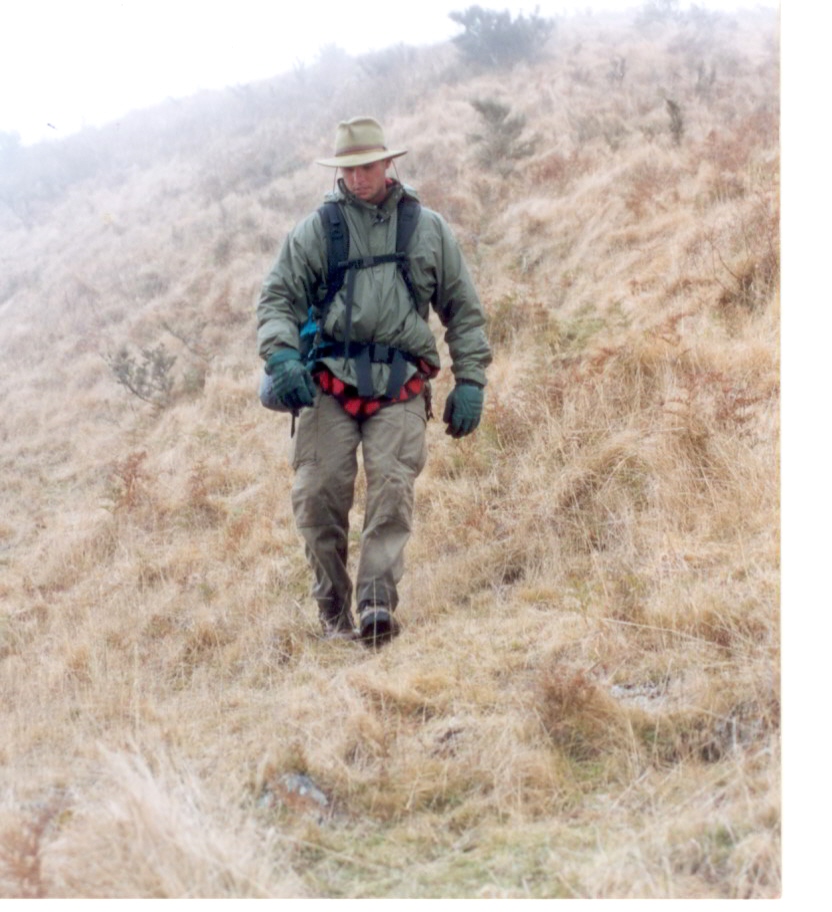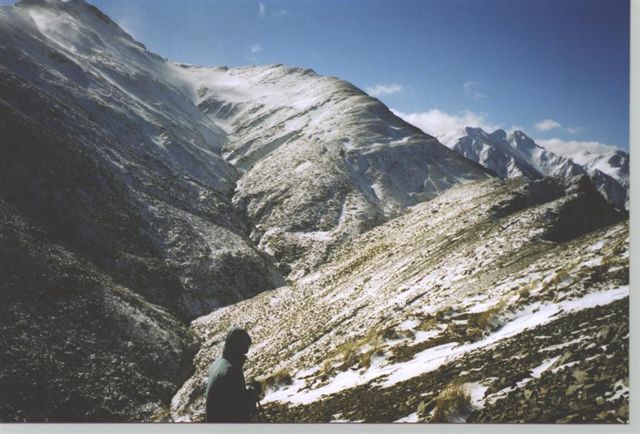
This past weekend Charlie, age 5, took his first real walk in the mountains. As with Taylor, whom first traversed in the Ruahines at age 7, I was filled with pride and love at being able to share this place I love so much with my sons. It was a beautiful winters day, and as can be seen from the above photo, The Rim of Fire, Ruapehu, Ngarahoe, and Tongariro, all active volcanoes, glistened under their blankets of ice and snow in the distance.
It was also a day for me to apply my experience and growth as both a father and a lover of mountains. With my older son Taylor I simply threw him in the deep end of the Ruahines. His first tramp ever was to Top Maropea for the night, a 5 hour trip, his second to Parks Peak even longer. He has been many places in the Ruahines I would suggest boys of 7 years on have not seen. Yet looking back I realize how hard I pushed him, my expectations more paramount than the capability of his little legs, to the point where honestly looking back it probably was not a lot of fun for either of us at times. Nothing that warm clothes, chocolate, and a warm fire at the hut did not fix, but over the years walking solo over those same routes I realize how hard it must have been for him. Which makes me feel both pride and guilt, not to mention love for Taylor.
So with Charlie my intention has always been a much slower paced and easier introduction to the mountains. My thinking is a series of day walks, just for fun, with no agenda or plan other than the dictates of his little legs. To let him be in that environment and truly see it, feel it, and enjoy it through the eyes of a child. It may sound simple, but that is a far easier scenario than carrying a heavy pack with a 4 or 5 hour walk through mountain terrain to arrive at a distant hut with a young boy. The tendency to watch every step, to look ahead at any possible danger, to try and hurry the pace a bit, looking at the time, gauging the distance to the hut, keeping him fed and warm, trying to distract his attention from the sheer distance ahead, can really build up to exhausting levels. And from a selfish point of view I still want to enjoy the mountains as well. I suspect those feelings will not go away with Charlie no matter how careful and sensitive I am with his introduction - he is my son, and the very instincts of my being a father will always come first. Perhaps by starting slower, and more relaxed, we can learn together.


Charlie's interaction with the Ruahines actually extends beyond his "first" actual tramp amongst them. Back in 2003, when he was born I "connected" him to the Ruahines through the Maori custom of Whenua, (fhen oo ahh). Whenua is a word meaning both land, and placenta. The placenta is returned to the earth, or buried, in the land from which it came, thereby connecting that person to the land. I realize Charlie did not come from the Ruahine, but in a large sense I experienced a re-birth there of sorts. So I carried Charlie's placenta up to Top Maropea and returned it to the earth beneath a small beech tree near the hut. I placed a small pile of rocks on top to mark it, and interestingly over the years that pile has grown into a fairly large pile known as Charlie's Cairn. So inside me the spiritual side I feel here, hopes that something inside Charlie is stirred a bit through the years, that he feels, and honours, the bond that lies waiting for him.



We went to the western side of the ranges, to an area called Rangiwahia. It is a track that sidles up the Mangahuia stream valley, to the open tops of the Whanahuia ranges, one of the 5 sub ranges comprising the Ruahine. When I first came this way in 1994 it was a very simple and fast way to the bottom of the open tops of the Whanahuia's and where is located Rangiwahia hut. While steep, it was an excellent track and when fit and carrying a large pack I have made it to Rangiwahia in a little over 90 minutes. Rangiwahia hut was a popular destination for large school groups and such, with the excellent track it offered little difficulty beyond the required upward exertion. 0ver the years gravity has come into play, and particularly around a certain section of the track. As it sidles high above the stream, and is very steep, the very nature of it dictates it being prone to slips. A period from 2001 to 2004 saw a series of massive slips, with the track being first rebuilt, then diverted higher and higher up the side of the valley. The last time I came through with John in early 2005 the track had been detoured and reopened only days before. And it was a nightmarish tangle of bush bashing, muddy pools, and a steep climb up from the detour and back down to the track. The detour covers perhaps 800 metres in total distance of the old track, maybe a 5-10 minute walk, but the detour adds over an hour onto the walk by the time it meets the old track. So what was a fairly easy 2 hour walk to the tops is now 3 plus hours with a fairly difficult 1 hour section included. Needless to say, the formerly popular Rangiwahia walk has dwindled to a small trickle. So my plan was to get Charlie up to the point of the detour, enjoy the day, have some lunch, and see what happened. And even in that first 30 minutes I thought when we reached the detour he was done, as he wanted nothing more than to sit and eat chocolate and rest. And that was actually fine with me. It was a beautiful day, and though the mountains were calling to me I was content to enjoy Charlie, the sun, the valley, and the sound of the stream below.


The first photo above is Charlie standing just beyond the detour and where the old benched track remnants can be clearly seen in the top portion of the photo. The drop from here to the stream is 100 metres or so, and pretty much straight down.
The second photo is a wider view of the slip area, some of which is regenerating but still very unstable. The detour climbs straight up to the top of the ridge, then undulates along it before dropping down near the sky line and meets up with the track once again.
As I sat in the sun enjoying the view, Charlie quickly regained his energy with the help of chocolate, cashews, and Pringle's chips. He was soon climbing up the start of the detour, and then decided he wanted to carry on. I thought okay, we can just see how far he gets, then turn around. The detour track has been much improved since 2005, though still very steep and with tricky footing in places. To my surprise, with him climbing ahead of me, and us chatting away practicing his spelling, stopping to look at the view and rest, we got to the top. Then with me descending in front with Charlie close behind we made our way down to the track. He fell a couple of times in the thick bush, but with me right in front preventing any major mishaps, he came right very quickly. Soon we were back on the track and made it to the distinctive wooden arch bridge which spans Mangahuia stream. The bridge spans the stream some 50 feet across and perhaps 150 straight down, and I must confess I felt a very sickly feeling in my stomach as Charlie looked over the edge, seemingly undaunted by the big drop. I was glad when we retreated back to the sun and a well deserved rest. Even though Rangiwahia hut was now only an hour away it was too far to go up to and return on this day. Plus we had still had to climb back up, over, and down the big slip. I knew though that if we rested long enough then pushed on to the hut to stay the night
Charlie would make it fine. Maybe one day this winter. He was quite keen to see some snow, and up there not too far away, in the right conditions, we would find a winter wonderland.



Charlie and I learned a lot this day. I learned my approach with him based on experience is the right one, to introduce him slowly to his Whenua and let it find him, and he it, on their own terms. Charlie learned that what he imagined the mountains to be in his mind is perhaps very different to what he found it to be, and in a very good way. I saw the way he carried himself, watched him observe his surroundings, finding beauty in the view, maybe even pondering a few deeper thoughts, maybe not. And he reminded me of the joy of seeing through the eyes of a child, of the vast difference between being a father and a parent, and how fortunate I am to share a place I love so much, with this child I love even more.
Aroha





























